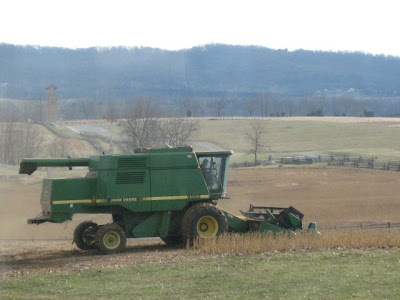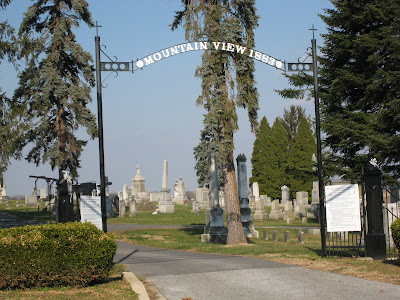---
Check it out here.
And happy new year to all.
Mannie
 Stonewall Jackson confers with S.D. Lee regarding the placement of Confederate aritllery on the Dunker Church plateau (church in background).
Stonewall Jackson confers with S.D. Lee regarding the placement of Confederate aritllery on the Dunker Church plateau (church in background).---
An online journal of Mannie Gentile, a National Park Service Park Ranger working on the National Mall in our nation's capital. DISCLAIMER: please note that this blog represents only my views and not those of the National Park Service. Feel free to email me at: museumofamerica@myactv.net
 Stonewall Jackson confers with S.D. Lee regarding the placement of Confederate aritllery on the Dunker Church plateau (church in background).
Stonewall Jackson confers with S.D. Lee regarding the placement of Confederate aritllery on the Dunker Church plateau (church in background). (not really my foot)
(not really my foot) I realized that my foot needed to enter the boot from the rear rather than the top, in the manner of a slipper, so the first step was to open up the seams and cut an entry down the back.
I realized that my foot needed to enter the boot from the rear rather than the top, in the manner of a slipper, so the first step was to open up the seams and cut an entry down the back.
 Holes for the stitching were punched and the first strap stitched into place. This is the strap that'll close the back of the boot.
Holes for the stitching were punched and the first strap stitched into place. This is the strap that'll close the back of the boot. This antique harness buckle was stitched to the other, larger, strap, the one that wraps around the ankle and snugs up the whole kit&kaboodle.
This antique harness buckle was stitched to the other, larger, strap, the one that wraps around the ankle and snugs up the whole kit&kaboodle.



 You are viewing this west of my position, you are looking east with the remains of the East Woods beyond the Cornfield in the foreground. Imagine if several regiments of your enemy were hidden from your view if you were advancing in this direction. Or imagine if your regiment, in line of battle, was advancing in a line parallel to the fence, suddenly your left flank or center would disappear from view. My, how confusing. Even more so when men are trying in earnest to kill you.
You are viewing this west of my position, you are looking east with the remains of the East Woods beyond the Cornfield in the foreground. Imagine if several regiments of your enemy were hidden from your view if you were advancing in this direction. Or imagine if your regiment, in line of battle, was advancing in a line parallel to the fence, suddenly your left flank or center would disappear from view. My, how confusing. Even more so when men are trying in earnest to kill you. Deep down in one of the ravines travelled by Early's men. Seldom did visitors venture into this area. Now, however the area is accessible on the Park's new West Woods trail.
Deep down in one of the ravines travelled by Early's men. Seldom did visitors venture into this area. Now, however the area is accessible on the Park's new West Woods trail. Your only concern is that little guidon snapping in the breeze.
Your only concern is that little guidon snapping in the breeze. and his 1,700-man division concealed from view just beyond the lip of the swale, which will rise up and destroy your regiment.
and his 1,700-man division concealed from view just beyond the lip of the swale, which will rise up and destroy your regiment.

 By about four o'clock the volunteers started fanning out across the battlefield lighting the candles in the very cold afternoon.
By about four o'clock the volunteers started fanning out across the battlefield lighting the candles in the very cold afternoon. As the sky grew dark the amazing happened again, those simple brown paper bags, weighted with sand and containing a single candle...
As the sky grew dark the amazing happened again, those simple brown paper bags, weighted with sand and containing a single candle...

 This is the burial ground for the Mumma family and although its surrounded by a gated stone wall, it is always open to visitors seeking shade, cooling breezes, and beautiful vistas.
This is the burial ground for the Mumma family and although its surrounded by a gated stone wall, it is always open to visitors seeking shade, cooling breezes, and beautiful vistas. This is the cemetery that has been the final resting place for generations of Sharpsburg residents since 1883. From its height you can look north for views of the Piper Farm and the Visitor Center, to the east, as the name implies are vistas of South Mountain and Elk Ridge.
This is the cemetery that has been the final resting place for generations of Sharpsburg residents since 1883. From its height you can look north for views of the Piper Farm and the Visitor Center, to the east, as the name implies are vistas of South Mountain and Elk Ridge. The massive statue of the Civil War soldier, known as Old Simon, stands sentinel over the graves of 4,776 Union soldiers, a continuing reminder of the price of freedom.
The massive statue of the Civil War soldier, known as Old Simon, stands sentinel over the graves of 4,776 Union soldiers, a continuing reminder of the price of freedom. The church that stood here during the savage fighting of September 17th 1862 is long gone, but the stones still bear silent witness to that terrible fight.
The church that stood here during the savage fighting of September 17th 1862 is long gone, but the stones still bear silent witness to that terrible fight. this member of the U.S. Colored Infantry, a veteran of the Civil War, and a messenger of emancipation.
this member of the U.S. Colored Infantry, a veteran of the Civil War, and a messenger of emancipation. The first burial was in 1775, the last in 1883 when Mountainview Cemetery opened and became the primary resting place for the good people of Sharpsburg.
The first burial was in 1775, the last in 1883 when Mountainview Cemetery opened and became the primary resting place for the good people of Sharpsburg. And unlike this replica, Jim's offering an book about the actual Hunley
And unlike this replica, Jim's offering an book about the actual Hunley
 Historic Harper's Ferry and a great hike along the C&O Canal (Two National Parks in one place!)
Historic Harper's Ferry and a great hike along the C&O Canal (Two National Parks in one place!) my homemade pizza!
my homemade pizza!


 Trail markers and maps are in position and just waiting for you.
Trail markers and maps are in position and just waiting for you.

 New siding has been placed over the new upright timbers outside the cattle stalls on the lower level.
New siding has been placed over the new upright timbers outside the cattle stalls on the lower level.
 Repair crews from the Maintenance Division got in to action immediately to first, stabilize the structure, and then begin the process of repair.
Repair crews from the Maintenance Division got in to action immediately to first, stabilize the structure, and then begin the process of repair. First the roofing gets stripped off, and then key timbers are cut, and then...
First the roofing gets stripped off, and then key timbers are cut, and then... I was able to hear the Crash! from the visitor center parking lot.
I was able to hear the Crash! from the visitor center parking lot. The wreckage was carted away and it became the turn for that little concrete block shed to yield to battlefield preservation.
The wreckage was carted away and it became the turn for that little concrete block shed to yield to battlefield preservation. Presto! As the remainder of wreckage is removed and the turf heals...
Presto! As the remainder of wreckage is removed and the turf heals... visitors will have this park-like view of the historic barn walls as well as the strategic Hauser Ridge beyond.
visitors will have this park-like view of the historic barn walls as well as the strategic Hauser Ridge beyond.